Analysis of JB Hi-Fi's Inventory Accounting Policies and Practices
VerifiedAdded on 2023/06/04
|7
|1146
|328
Report
AI Summary
This report provides an analysis of JB Hi-Fi's inventory accounting policies, focusing on the financial year 2018. It examines the company's use of the lower of cost or net realisable value for closing inventory valuation, a practice deemed suitable given the potential for obsolescence in its product range. The report highlights the use of the weighted average cost method for inventory costing and discusses its impact on the cost of goods sold, profit, and inventory valuation. It also emphasizes the importance of adhering to AASB 102 and considering factors like the nature of the business and inventory durability when designing inventory policies. The report further discusses the implications of inventory valuation on profitability and cost in the income statement and concludes with a summary of key considerations for inventory accounting decisions.
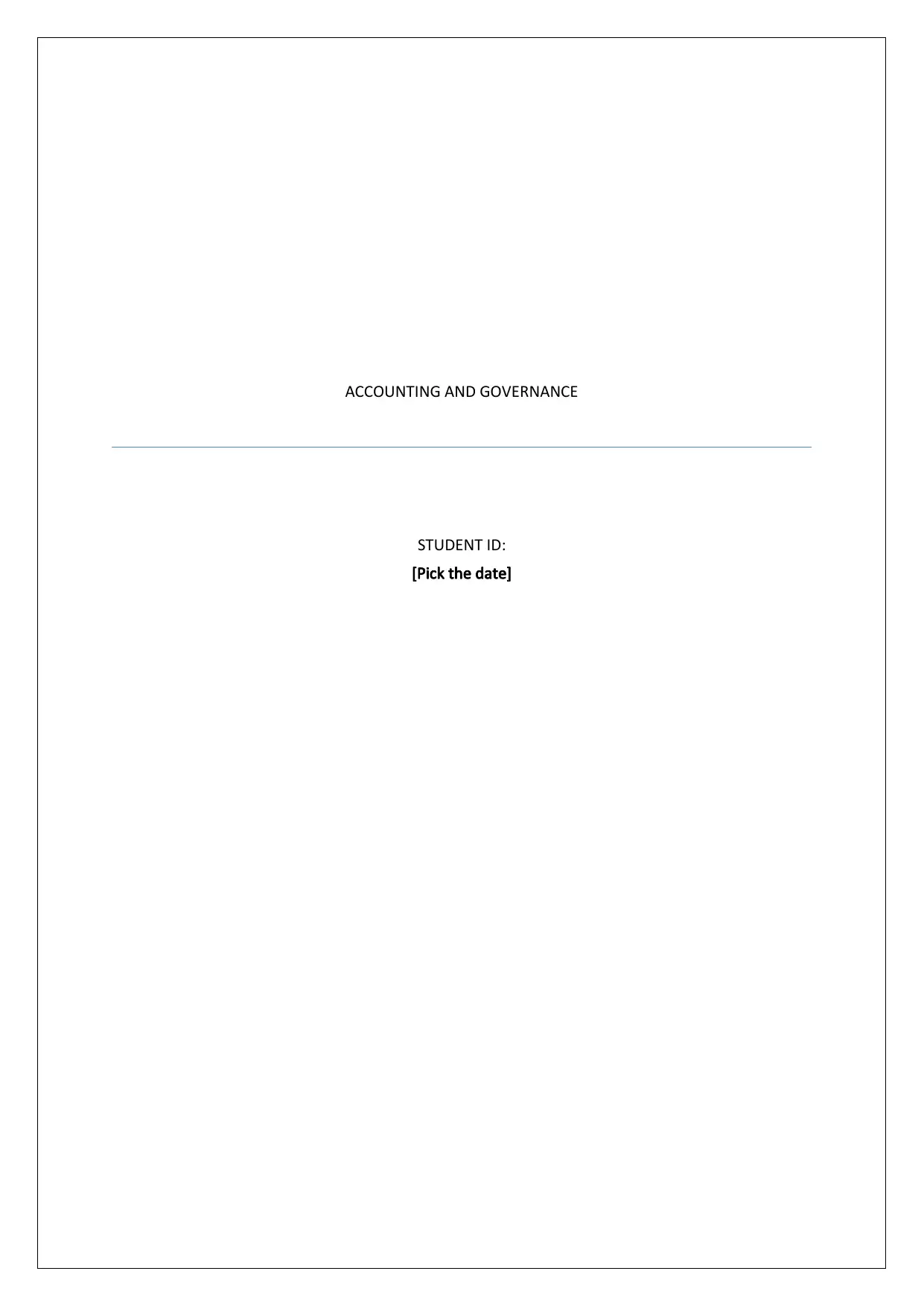
ACCOUNTING AND GOVERNANCE
STUDENT ID:
[Pick the date]
STUDENT ID:
[Pick the date]
Paraphrase This Document
Need a fresh take? Get an instant paraphrase of this document with our AI Paraphraser
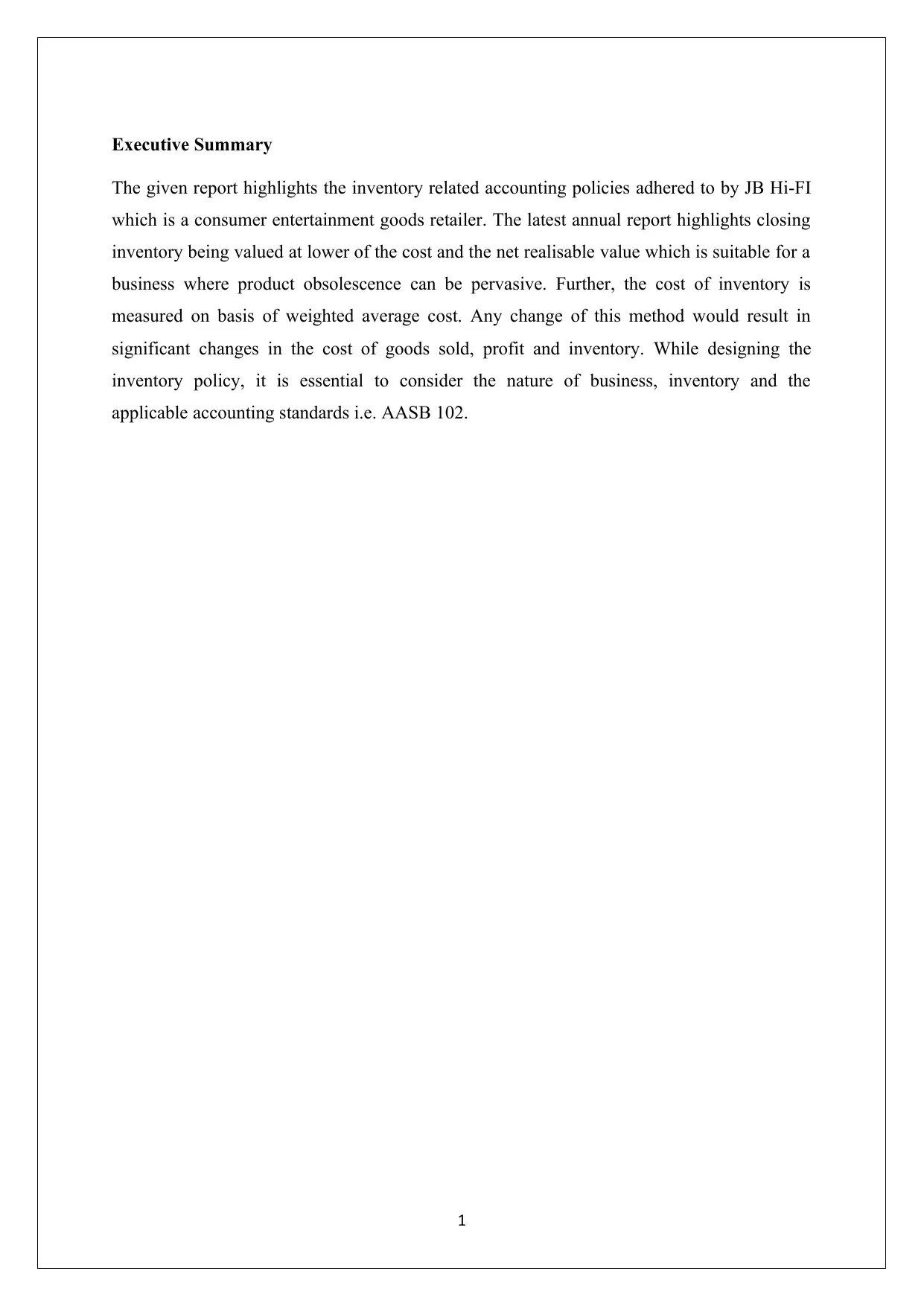
Executive Summary
The given report highlights the inventory related accounting policies adhered to by JB Hi-FI
which is a consumer entertainment goods retailer. The latest annual report highlights closing
inventory being valued at lower of the cost and the net realisable value which is suitable for a
business where product obsolescence can be pervasive. Further, the cost of inventory is
measured on basis of weighted average cost. Any change of this method would result in
significant changes in the cost of goods sold, profit and inventory. While designing the
inventory policy, it is essential to consider the nature of business, inventory and the
applicable accounting standards i.e. AASB 102.
1
The given report highlights the inventory related accounting policies adhered to by JB Hi-FI
which is a consumer entertainment goods retailer. The latest annual report highlights closing
inventory being valued at lower of the cost and the net realisable value which is suitable for a
business where product obsolescence can be pervasive. Further, the cost of inventory is
measured on basis of weighted average cost. Any change of this method would result in
significant changes in the cost of goods sold, profit and inventory. While designing the
inventory policy, it is essential to consider the nature of business, inventory and the
applicable accounting standards i.e. AASB 102.
1
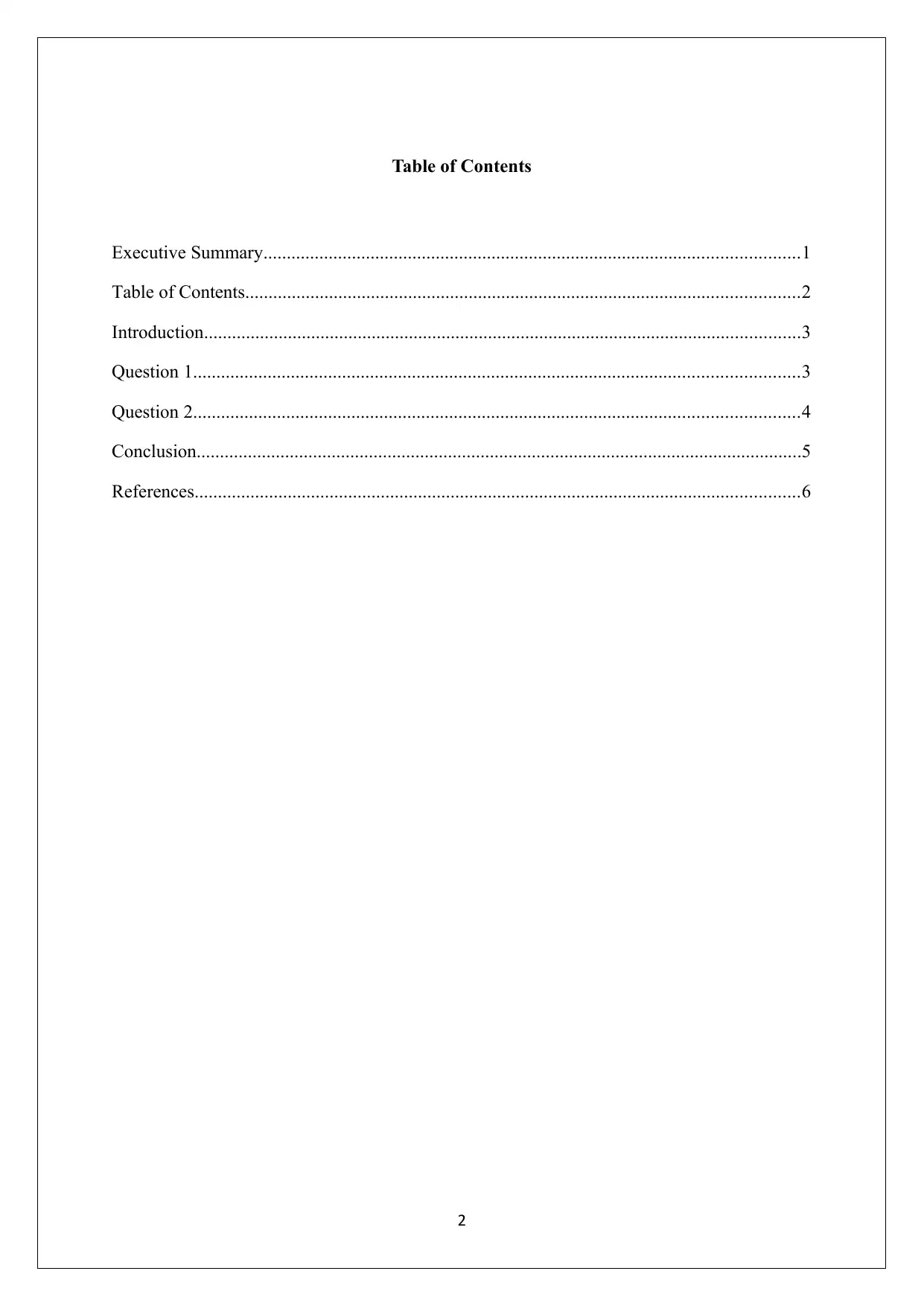
Table of Contents
Executive Summary...................................................................................................................1
Table of Contents.......................................................................................................................2
Introduction................................................................................................................................3
Question 1..................................................................................................................................3
Question 2..................................................................................................................................4
Conclusion..................................................................................................................................5
References..................................................................................................................................6
2
Executive Summary...................................................................................................................1
Table of Contents.......................................................................................................................2
Introduction................................................................................................................................3
Question 1..................................................................................................................................3
Question 2..................................................................................................................................4
Conclusion..................................................................................................................................5
References..................................................................................................................................6
2
⊘ This is a preview!⊘
Do you want full access?
Subscribe today to unlock all pages.

Trusted by 1+ million students worldwide
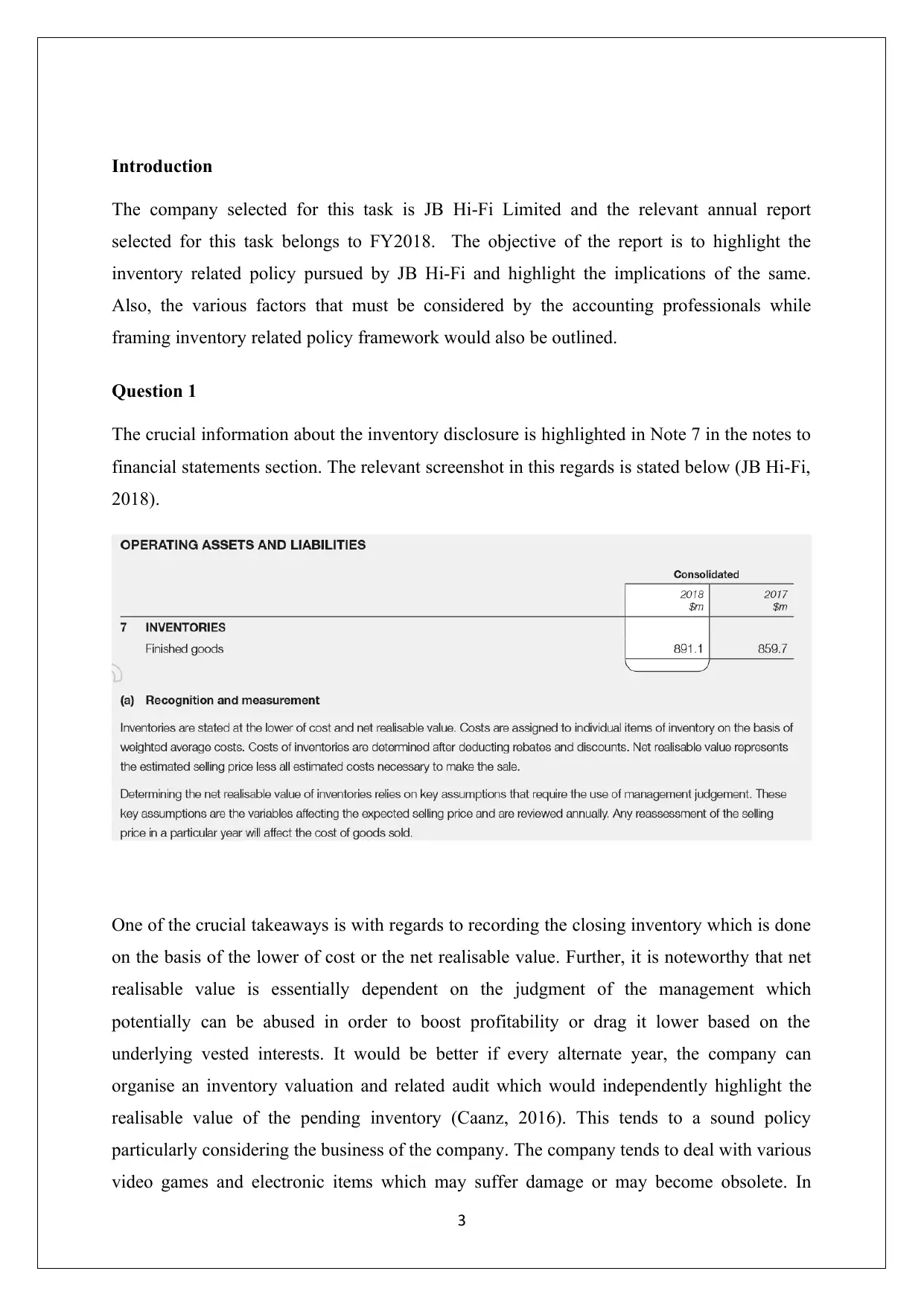
Introduction
The company selected for this task is JB Hi-Fi Limited and the relevant annual report
selected for this task belongs to FY2018. The objective of the report is to highlight the
inventory related policy pursued by JB Hi-Fi and highlight the implications of the same.
Also, the various factors that must be considered by the accounting professionals while
framing inventory related policy framework would also be outlined.
Question 1
The crucial information about the inventory disclosure is highlighted in Note 7 in the notes to
financial statements section. The relevant screenshot in this regards is stated below (JB Hi-Fi,
2018).
One of the crucial takeaways is with regards to recording the closing inventory which is done
on the basis of the lower of cost or the net realisable value. Further, it is noteworthy that net
realisable value is essentially dependent on the judgment of the management which
potentially can be abused in order to boost profitability or drag it lower based on the
underlying vested interests. It would be better if every alternate year, the company can
organise an inventory valuation and related audit which would independently highlight the
realisable value of the pending inventory (Caanz, 2016). This tends to a sound policy
particularly considering the business of the company. The company tends to deal with various
video games and electronic items which may suffer damage or may become obsolete. In
3
The company selected for this task is JB Hi-Fi Limited and the relevant annual report
selected for this task belongs to FY2018. The objective of the report is to highlight the
inventory related policy pursued by JB Hi-Fi and highlight the implications of the same.
Also, the various factors that must be considered by the accounting professionals while
framing inventory related policy framework would also be outlined.
Question 1
The crucial information about the inventory disclosure is highlighted in Note 7 in the notes to
financial statements section. The relevant screenshot in this regards is stated below (JB Hi-Fi,
2018).
One of the crucial takeaways is with regards to recording the closing inventory which is done
on the basis of the lower of cost or the net realisable value. Further, it is noteworthy that net
realisable value is essentially dependent on the judgment of the management which
potentially can be abused in order to boost profitability or drag it lower based on the
underlying vested interests. It would be better if every alternate year, the company can
organise an inventory valuation and related audit which would independently highlight the
realisable value of the pending inventory (Caanz, 2016). This tends to a sound policy
particularly considering the business of the company. The company tends to deal with various
video games and electronic items which may suffer damage or may become obsolete. In
3
Paraphrase This Document
Need a fresh take? Get an instant paraphrase of this document with our AI Paraphraser
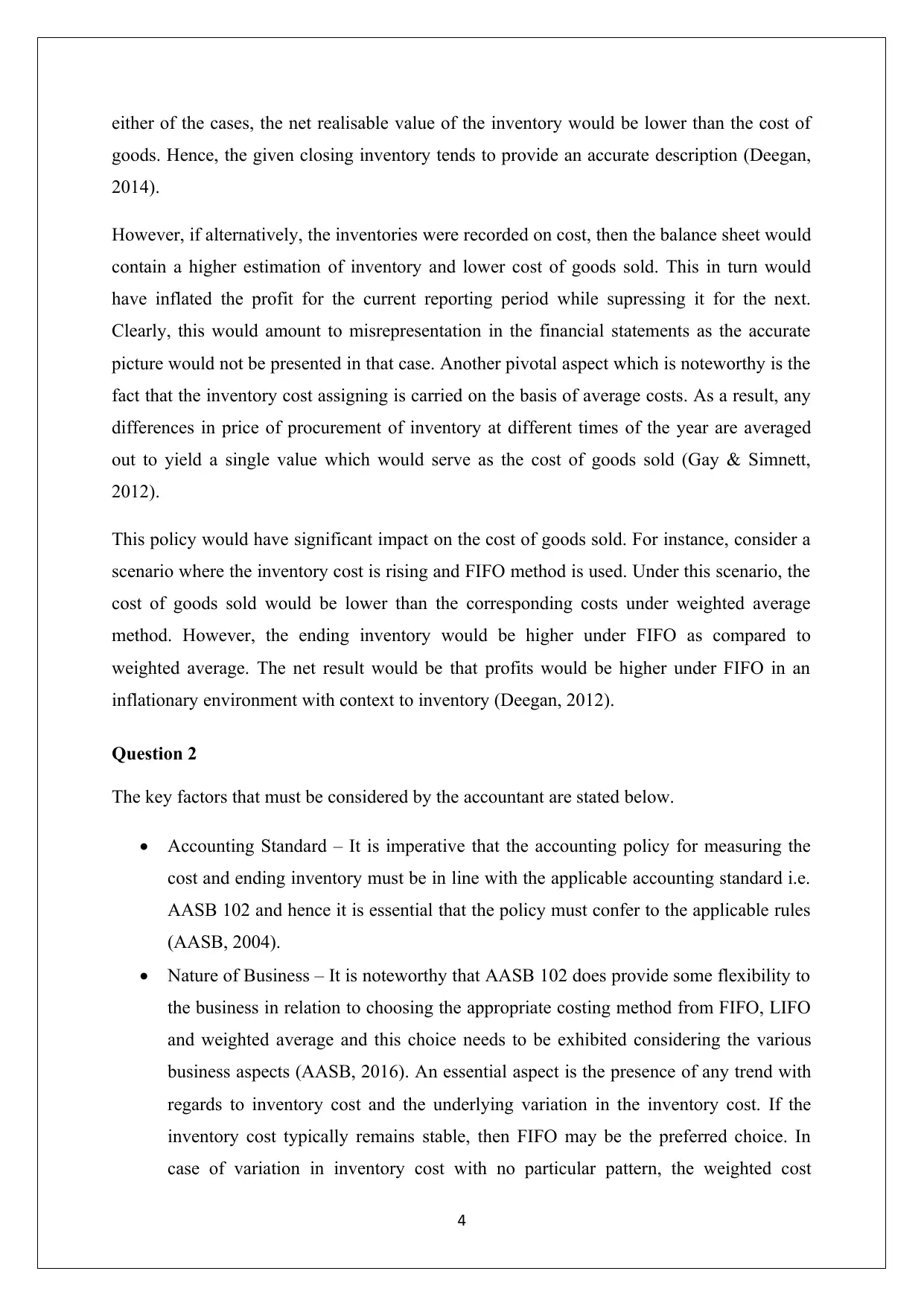
either of the cases, the net realisable value of the inventory would be lower than the cost of
goods. Hence, the given closing inventory tends to provide an accurate description (Deegan,
2014).
However, if alternatively, the inventories were recorded on cost, then the balance sheet would
contain a higher estimation of inventory and lower cost of goods sold. This in turn would
have inflated the profit for the current reporting period while supressing it for the next.
Clearly, this would amount to misrepresentation in the financial statements as the accurate
picture would not be presented in that case. Another pivotal aspect which is noteworthy is the
fact that the inventory cost assigning is carried on the basis of average costs. As a result, any
differences in price of procurement of inventory at different times of the year are averaged
out to yield a single value which would serve as the cost of goods sold (Gay & Simnett,
2012).
This policy would have significant impact on the cost of goods sold. For instance, consider a
scenario where the inventory cost is rising and FIFO method is used. Under this scenario, the
cost of goods sold would be lower than the corresponding costs under weighted average
method. However, the ending inventory would be higher under FIFO as compared to
weighted average. The net result would be that profits would be higher under FIFO in an
inflationary environment with context to inventory (Deegan, 2012).
Question 2
The key factors that must be considered by the accountant are stated below.
Accounting Standard – It is imperative that the accounting policy for measuring the
cost and ending inventory must be in line with the applicable accounting standard i.e.
AASB 102 and hence it is essential that the policy must confer to the applicable rules
(AASB, 2004).
Nature of Business – It is noteworthy that AASB 102 does provide some flexibility to
the business in relation to choosing the appropriate costing method from FIFO, LIFO
and weighted average and this choice needs to be exhibited considering the various
business aspects (AASB, 2016). An essential aspect is the presence of any trend with
regards to inventory cost and the underlying variation in the inventory cost. If the
inventory cost typically remains stable, then FIFO may be the preferred choice. In
case of variation in inventory cost with no particular pattern, the weighted cost
4
goods. Hence, the given closing inventory tends to provide an accurate description (Deegan,
2014).
However, if alternatively, the inventories were recorded on cost, then the balance sheet would
contain a higher estimation of inventory and lower cost of goods sold. This in turn would
have inflated the profit for the current reporting period while supressing it for the next.
Clearly, this would amount to misrepresentation in the financial statements as the accurate
picture would not be presented in that case. Another pivotal aspect which is noteworthy is the
fact that the inventory cost assigning is carried on the basis of average costs. As a result, any
differences in price of procurement of inventory at different times of the year are averaged
out to yield a single value which would serve as the cost of goods sold (Gay & Simnett,
2012).
This policy would have significant impact on the cost of goods sold. For instance, consider a
scenario where the inventory cost is rising and FIFO method is used. Under this scenario, the
cost of goods sold would be lower than the corresponding costs under weighted average
method. However, the ending inventory would be higher under FIFO as compared to
weighted average. The net result would be that profits would be higher under FIFO in an
inflationary environment with context to inventory (Deegan, 2012).
Question 2
The key factors that must be considered by the accountant are stated below.
Accounting Standard – It is imperative that the accounting policy for measuring the
cost and ending inventory must be in line with the applicable accounting standard i.e.
AASB 102 and hence it is essential that the policy must confer to the applicable rules
(AASB, 2004).
Nature of Business – It is noteworthy that AASB 102 does provide some flexibility to
the business in relation to choosing the appropriate costing method from FIFO, LIFO
and weighted average and this choice needs to be exhibited considering the various
business aspects (AASB, 2016). An essential aspect is the presence of any trend with
regards to inventory cost and the underlying variation in the inventory cost. If the
inventory cost typically remains stable, then FIFO may be the preferred choice. In
case of variation in inventory cost with no particular pattern, the weighted cost
4
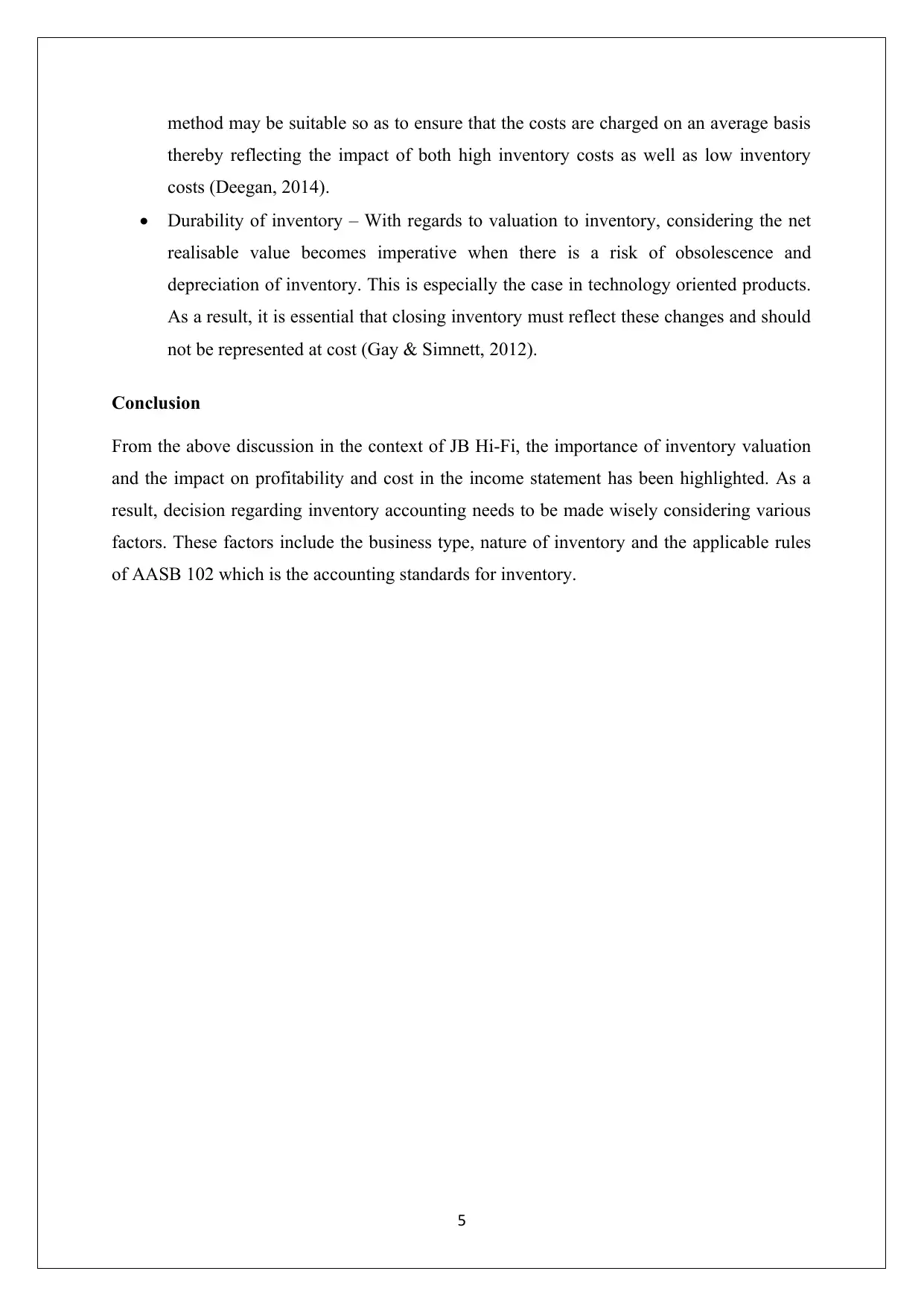
method may be suitable so as to ensure that the costs are charged on an average basis
thereby reflecting the impact of both high inventory costs as well as low inventory
costs (Deegan, 2014).
Durability of inventory – With regards to valuation to inventory, considering the net
realisable value becomes imperative when there is a risk of obsolescence and
depreciation of inventory. This is especially the case in technology oriented products.
As a result, it is essential that closing inventory must reflect these changes and should
not be represented at cost (Gay & Simnett, 2012).
Conclusion
From the above discussion in the context of JB Hi-Fi, the importance of inventory valuation
and the impact on profitability and cost in the income statement has been highlighted. As a
result, decision regarding inventory accounting needs to be made wisely considering various
factors. These factors include the business type, nature of inventory and the applicable rules
of AASB 102 which is the accounting standards for inventory.
5
thereby reflecting the impact of both high inventory costs as well as low inventory
costs (Deegan, 2014).
Durability of inventory – With regards to valuation to inventory, considering the net
realisable value becomes imperative when there is a risk of obsolescence and
depreciation of inventory. This is especially the case in technology oriented products.
As a result, it is essential that closing inventory must reflect these changes and should
not be represented at cost (Gay & Simnett, 2012).
Conclusion
From the above discussion in the context of JB Hi-Fi, the importance of inventory valuation
and the impact on profitability and cost in the income statement has been highlighted. As a
result, decision regarding inventory accounting needs to be made wisely considering various
factors. These factors include the business type, nature of inventory and the applicable rules
of AASB 102 which is the accounting standards for inventory.
5
⊘ This is a preview!⊘
Do you want full access?
Subscribe today to unlock all pages.

Trusted by 1+ million students worldwide
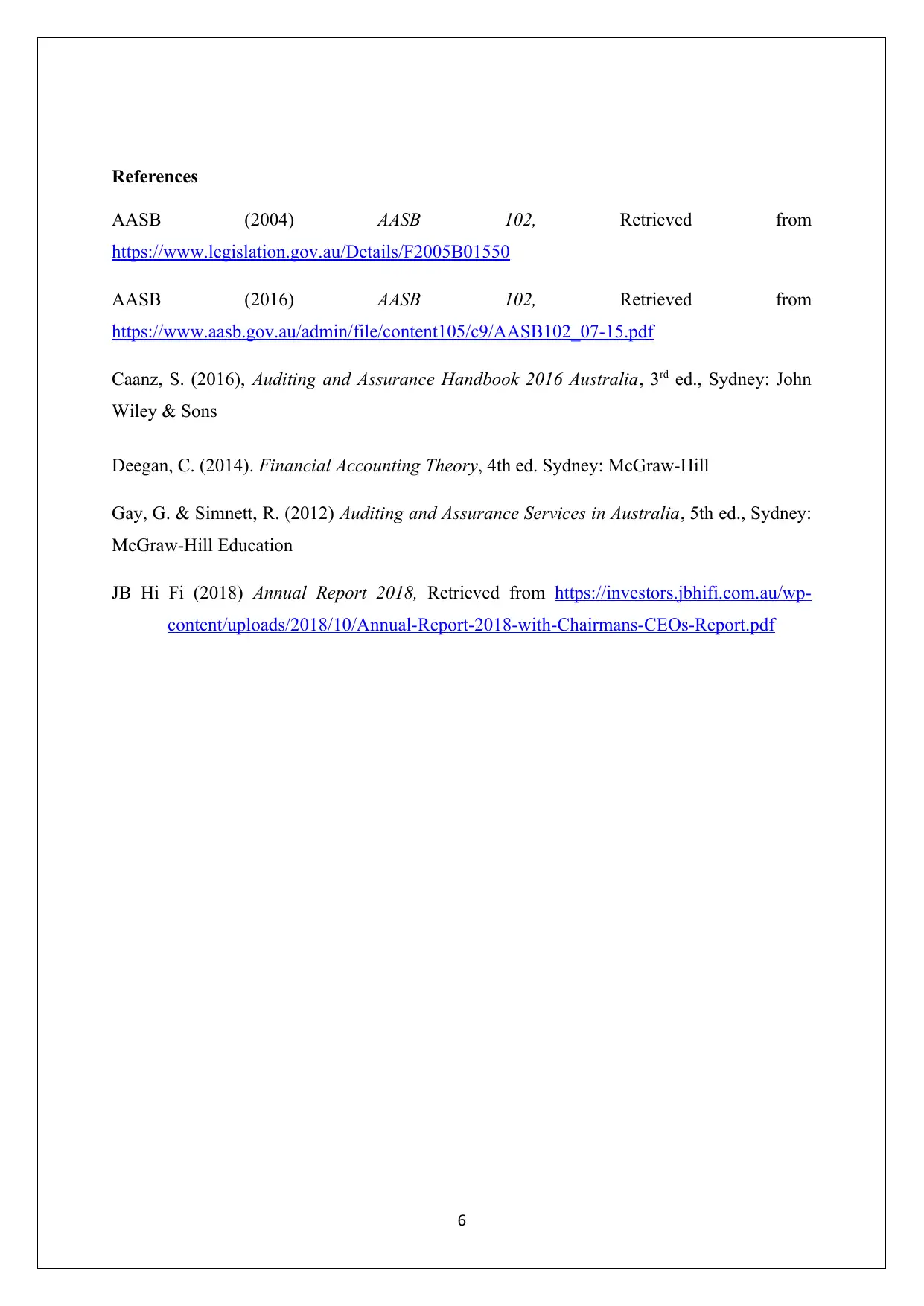
References
AASB (2004) AASB 102, Retrieved from
https://www.legislation.gov.au/Details/F2005B01550
AASB (2016) AASB 102, Retrieved from
https://www.aasb.gov.au/admin/file/content105/c9/AASB102_07-15.pdf
Caanz, S. (2016), Auditing and Assurance Handbook 2016 Australia, 3rd ed., Sydney: John
Wiley & Sons
Deegan, C. (2014). Financial Accounting Theory, 4th ed. Sydney: McGraw-Hill
Gay, G. & Simnett, R. (2012) Auditing and Assurance Services in Australia, 5th ed., Sydney:
McGraw-Hill Education
JB Hi Fi (2018) Annual Report 2018, Retrieved from https://investors.jbhifi.com.au/wp-
content/uploads/2018/10/Annual-Report-2018-with-Chairmans-CEOs-Report.pdf
6
AASB (2004) AASB 102, Retrieved from
https://www.legislation.gov.au/Details/F2005B01550
AASB (2016) AASB 102, Retrieved from
https://www.aasb.gov.au/admin/file/content105/c9/AASB102_07-15.pdf
Caanz, S. (2016), Auditing and Assurance Handbook 2016 Australia, 3rd ed., Sydney: John
Wiley & Sons
Deegan, C. (2014). Financial Accounting Theory, 4th ed. Sydney: McGraw-Hill
Gay, G. & Simnett, R. (2012) Auditing and Assurance Services in Australia, 5th ed., Sydney:
McGraw-Hill Education
JB Hi Fi (2018) Annual Report 2018, Retrieved from https://investors.jbhifi.com.au/wp-
content/uploads/2018/10/Annual-Report-2018-with-Chairmans-CEOs-Report.pdf
6
1 out of 7
Related Documents
Your All-in-One AI-Powered Toolkit for Academic Success.
+13062052269
info@desklib.com
Available 24*7 on WhatsApp / Email
![[object Object]](/_next/static/media/star-bottom.7253800d.svg)
Unlock your academic potential
Copyright © 2020–2025 A2Z Services. All Rights Reserved. Developed and managed by ZUCOL.




